Millennium Park
University of Florida Vertebrate Fossil Localities PI018 and PI028
Location
The site is located within the boundaries of Boca Ciega Millennium Park, Seminole, Pinellas County County, Florida. 27.83º N; 82.81º W.
Age
- Latest Pleistocene Epoch; late Rancholabrean land mammal age
- 18,000-12,000 years ago
Basis of Age
The presence of Bison is indicative of the Rancholabrean and the co-occurrence of these extant rodent species, Sigmodon hispidus, Peromyscus gossypinus, Oryzomys palustris, Microtus pinetorum, and Neofiber alleni, indicate a late Rancholabrean age in the chronologic sequence of Florida’s Pleistocene faunas (Morgan and Hulbert, 1996). Worked flakes of chert place the age in the latest Pleistocene.
Geology
The fossil-bearing unit varies from 30 to almost 130 cm thick and extends for a distance of at least 75 meters (80 yards) and probably farther. It consists primarily of very fine sand- to silt-sized, angular to subrounded quartz grains mixed with clay- to silt-sized particles of organic debris and clay. Small, thin zones containing substantial amounts of coarse sand- to granule-sized, subrounded to rounded grains of phosphate, mollusk shell fragments, ironstone, and quartz occur locally, particularly towards the bottom of the bed. These zones tended to have the most fossils. This unit is the equivalent of the “well-sorted brown sand” facies of Davis et al. (2003) that they dated as latest Pleistocene. Overlying the bone bed was about a one-meter-thick layer of unconsolidated white sand and modern organic debris. The fossil-bear unit extends down to the local water table. Excavating into the water-saturated, unconsolidated sediment below the fossil bed was difficult, but it appeared to primarily consist of fine grained, pure quartz sand.
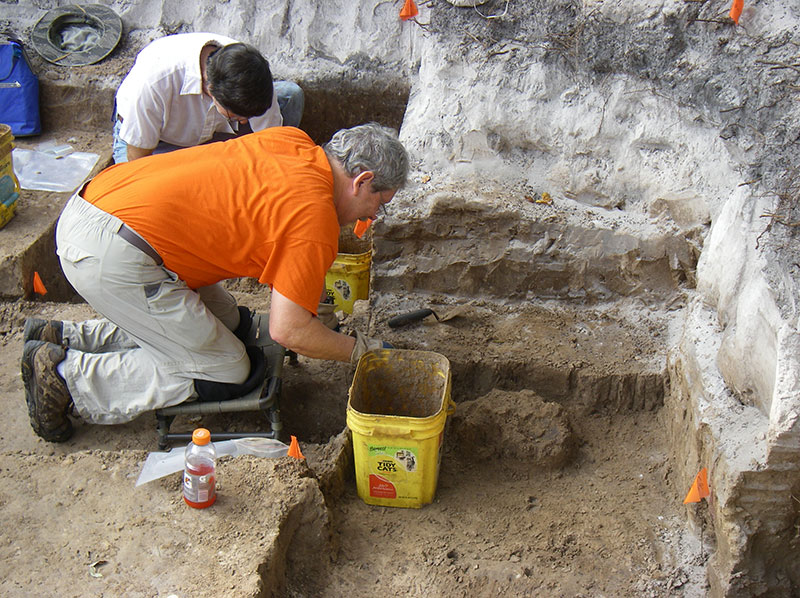
The mineralogic composition of the sediments making up the fossil-bearing unit at the Millennium Park Site suggests they are the erosional products of two different source rocks, the Miocene Arcadia Formation and a middle to late Pleistocene shell-rich unit such as the Fort Thompson Formation. These are known to occur in Pinellas County (Scott, 1988; Karrow et al., 1996; Ferguson and Davis, 2003). The Arcadia Formation would have provided the phosphate and some of the quartz, while the fragments of marine mollusk shells and the rest of the quartz were derived from the shell bed. Supporting this hypothesis is the presence of two types of reworked marine fossils in the fossil-bearing unit. One consists of darkly colored, typically waterworn specimens of small shark teeth and bony fish teeth and bones. This assemblage includes the extinct nurse shark Ginglymostoma delfortriei, along with a few rare terrestrial mammals that are diagnostic to the Miocene, and has been assigned UF locality code PI021. In addition to the shells, the Pleistocene reworked fossil assemblage (UF locality code PI022) contains small shark teeth including specimens of the extant nurse shark Ginglymostoma cirratum. This group of fossils are lighter in color and do not show the waterwear found in the Miocene specimens. Note that for the remainder of this account, discussion of the Millennium Park fossils only concerns the late Pleistocene specimens and not the reworked ones.
Depositional Environment
A low-lying depression in a dry prairie.
Fossils
Over 200,000 vertebrate fossils were collected at the Millennium Park Site. However, only a small percentage of that, approximately 3 to 5%, are complete enough to be identified. At the present time about 2,800 specimens are cataloged in the Florida Museum of Natural History. Those complete enough to be identified were mostly very sturdy, durable, and compact bones and teeth. The identifiable fraction is almost evenly divided between reptiles and mammals, with relatively few fish, amphibians, and birds. For the mammals, about 40% of the identifiable fossils were isolated teeth, 32% were osteoderms of armadillos, pampatheres, and glyptodonts, 7% were limb bones, and about 3.5% each were vertebrae, toes and metapodials, and mandibles and maxillae. Very few of the limbs and none of the jaws were complete. For the reptiles, the most commonly recovered bones were pieces of turtle and tortoise shell (about 40%), tortoise osteoderms (34%), and snake vertebrae (20%).
Broken surfaces of bones and teeth were rough and angular, not rounded or polished. Most unidentifiable fragments were between 5 and 100 mm (0.2-4 inches) in their longest dimension, but some very large fragments (presumably proboscidean) exceeding 300 mm (12 inches) in their longest dimension were recovered. Examples of weathering stages 1 through 4 of Behrensmyer (1978) were all observed, but here the originally intact specimens frequently appeared to crack and then splinter into long, narrow fragments without going through the extensive flaking observed in modern East Africa. This could mean some combination of weathering followed by trampling was commonplace and led to the high percentage of unidentifiable specimens. Bone surfaces very often show varying degrees of pitting or corrosion similar to damage caused by bacteria, fungi, and plants. The rare well-preserved specimens showing no evidence of cracking or other surface damage not surprisingly tend to be among the most complete, such as a Glyptotherium dentary. No bite marks nor other evidence of damage done by carnivore gnawing was observed. Only one specimen, a llama metapodial, showed cut marks of possible human origin. About a third of the small mammal teeth showed the corrosive effects of stomach acids from either avian or mammalian predators.
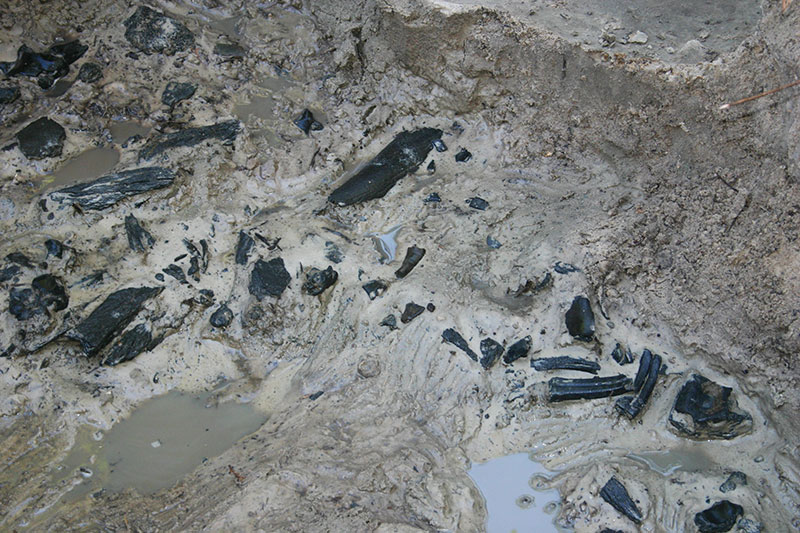
The characteristics of the Millennium Park fossils both in terms of bone element representation and bone surface modification, suggest prolonged exposure in a relatively dry (or alternating wet/dry), open, warm environment prior to burial. This resulted in the complete destruction of most of the weaker, thin-walled bones as well as the weaker portions of others, such as the spines on vertebrae. The very high percentage of relatively well preserved osteoderms, both from glyptodonts and tortoises, is an unusual feature of the site. Although these elements are sturdy, they do not have a thick outer layer of compact bone to minimize damage from corrosive agents like plants and fungi. One possible explanation is that this is simply a result of each individual tortoise or glyptodont having many hundreds of osteoderms. Thus the carcasses of tens of individuals of each species would originally contain a total of many thousands of osteoderms. Even if the survival rate for osteoderms was low, such as 10%, that means many hundreds would be preserved. But if that were the case, then even greater relative numbers of osteoderms should be found at Florida localities which have better preserved fossils. An alternate hypothesis to explain the relative high survival rate of these osteoderms compared to limb bones at Millennium Park is that in a dry environment, pieces of thick skin embedded with osteoderms could harden and cure, forming a leather-like protective barrier against damage from UV radiation and other agents of bone modification.
At the present time 33 taxa of mammals, 1 bird, 22 reptiles, 4 amphibians, and 3 fish are recognized in the fauna. Significant curation remains to be done on the Millennium Park fossils, particularly those collected in the 2012-2013 excavation, so additional species may be identified. And research done on the site and its fauna are still in the preliminary stages, so some of the identifications in the faunal list below are subject to change.
Excavation History and Methods
The Millennium Park Site was discovered by accident by a local high school student, Sierra Sarti-Sweeney, in January 2007. She was in the park doing photography when she found most of a lower jaw of a mammoth eroding out of the bank of a small creek. Park officials were informed of the find and they collected some additional fossils in the area. Park Supervisor Judy Jarosz contacted the Tampa Bay Fossil Club, a well-organized association of fossil collectors, and was a strong supporter of allowing collection of the fossils. Members of the Tampa Bay Fossil Club very quickly organized a collecting plan and diligently worked at the site many times between February and July of 2007 (Figures 3-4).
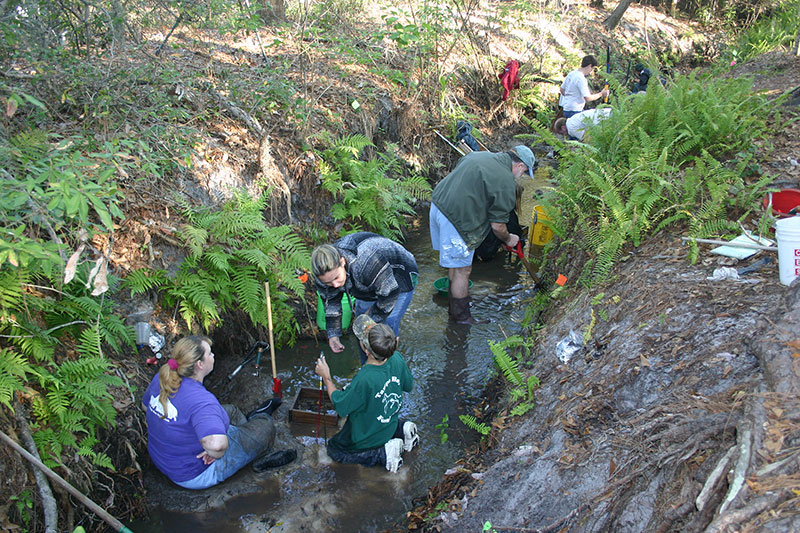
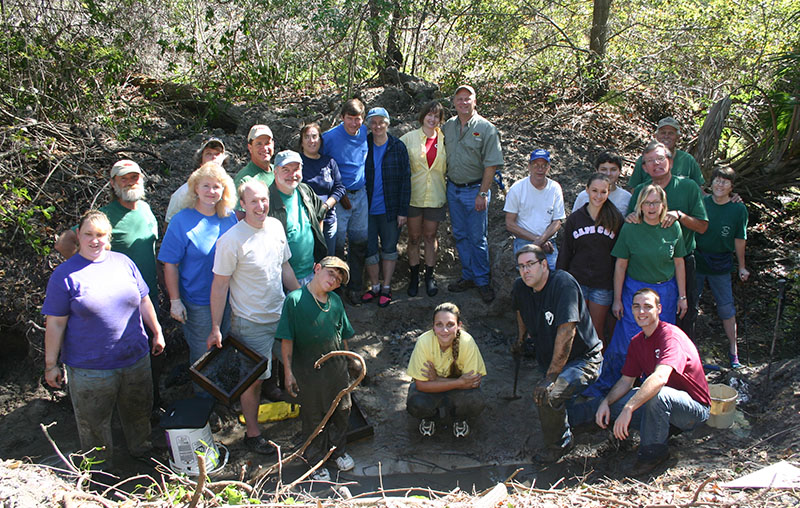
The 2007 excavations at the Millennium Park Site were centered on the bed and banks of a small creek that runs from an excavated artificial pond in the park to Boca Ciega Bay. Excavation methods were generally those used by fossil collectors in Florida rivers. The sediment in the bed of the river was screened on-site (Figure 3). Park officials allowed minor excavations into the banks of the creek, where in-situ specimens were found just above water level (Figure 2).
All of the fossils collected in 2007 were donated to the Florida Museum of Natural History in 2009 by the Pinellas County Board of Commissioners. Following their identification and cataloging in 2010-2011, Richard Hulbert recognized that the relative abundances of the species were very different from those of “typical” Florida late Pleistocene sites. Hulbert et al. (2011) gave a talk on the Millennium Park Site and its unusual fauna at the Annual Meeting of the Society of Vertebrate Paleontology in November 2011. Recognizing the need for additional in situ collecting and collection of sediment for screenwashing to recover more small vertebrate fossils, Hulbert, Peter Meylan of Eckerd College, and Mike Searle of the Tampa Bay Fossil Club located an area of about 10 × 20 meters near the creek that contained no mature trees. Hulbert and Meylan wrote a successful proposal to the Pinellas County Parks to get permission to excavate fossils in that area, as well as do additional collecting in the creek bed.
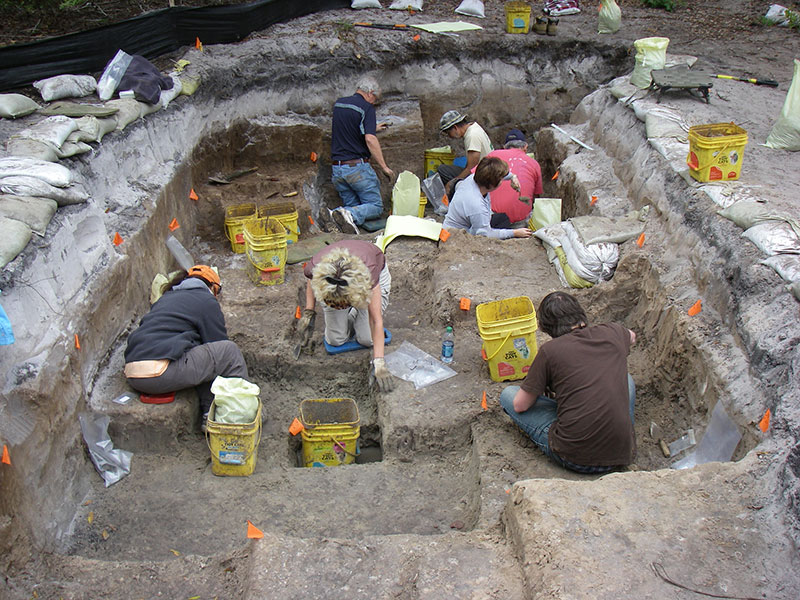
In late October 2012 a crew from the University of Florida and the Tampa Bay Fossil Club cleared all modern vegetation from the proposed excavation site. A grid system of 1 × 1 meter squares was established by Hulbert and Art Poyer (Figure 5). Half of the site was excavated down to the water table in November 2012 by UF students taking a Florida field paleontology course and Florida Museum volunteers. The other half was excavated in January 2013 by museum volunteers and students from Eckerd College taking a course from Dr. Meylan. These excavations recovered partial skeletons scattered across several meters of a bison, horse, and llama. A large volume of sediment from the bone layer were collected for screenwashing, and in situ samples were taken to analyze for fossil pollen (unfortunately, no pollen was present). Following the 2013 excavation the site was backfilled. The creek bed was again worked by members of the Tampa Bay Fossil Club in November 2012 and January 2013. The first bison horn core was discovered in the creek by club member John Cronin in November (its significance discussed below).
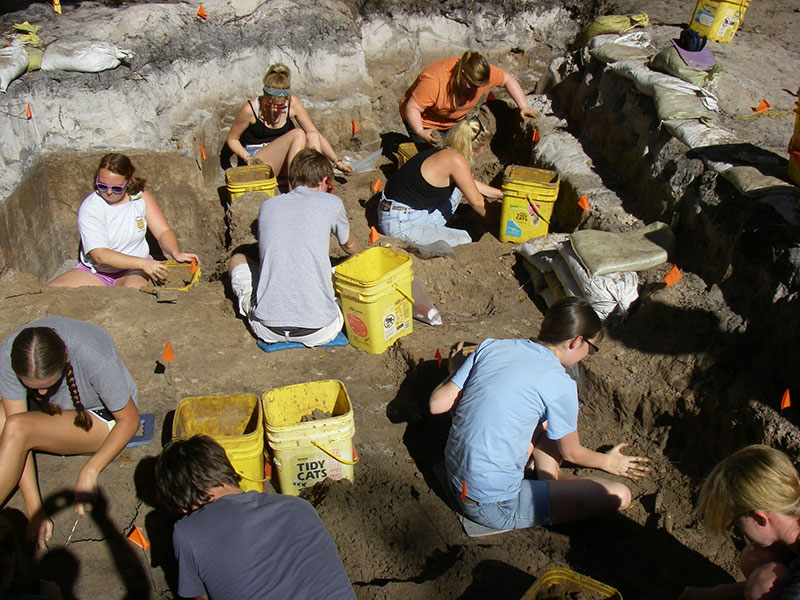
Collecting fossils or other natural history objects in any Pinellas County park is not allowed without permission from park authorities.
Discussion
Because of other on-going curation projects, most of the fossils recovered during the 2012/2013 field season remain uncurated and have not been studied or analyzed. So this account is primarily based on the specimens collected in 2007, augmented by field notes taken during the more recent dig. Comparing the list of species present at the Millennium Park site with those from similar age localities in Florida, such as the Melbourne, Vero Canal, and Seminole Field sites, reveals few significant differences. Because of these and many other sites, the late Pleistocene vertebrate fauna of Florida is relatively well known. But the relative abundances of the species at Millennium Park and few other sites in western Florida are very different from those found at other rich vertebrate fossil localities Florida. A notable absence is the lack of the mastodon (Mammut americanum) at Millennium Park, which is very unusual for a Florida late Pleistocene that produces megafauna. Ground sloths are unusually rare for a Florida site, with only one species present and it known from only a few specimens.
The “typical” late Pleistocene site in Florida has more browsing large herbivores, such as mastodon, tapir, deer, sloth, and llama, than grazing large herbivores such as mammoth, bison, and horse. Freshwater aquatic and semiaquatic species of salamanders, snakes, turtles, alligators, and birds are usually very common. At Millennium Park, grazers far outnumber browsers among large mammalian herbivores and land snakes, terrestrial box turtles, and land tortoises are more common than their aquatic counterparts. The makeup of the Millennium Park fossils suggests a relatively open, grassy habitat, similar to that the modern dry prairie ecosystem in south-central Florida, with relatively few areas of forest or bodies of permanent water (Hulbert et al, 2011). Ecologists and paleontologists have hypothesized that dry prairie and other grassland habitats were more widespread in Florida and the rest of the Southeast in the Pleistocene than at present (Weigl and Knowles, 1995; Rich et al., 2009; Noss, 2012). This is because of greater numbers of large mammalian herbivores, whose presence and activities promote open, grassy habitats (Owen-Smith, 1987; Knapp et al., 1999) along with lower water tables.
This habitat reconstruction is supported by the relative abundance and size of cotton rat teeth at the Millennium Park Site. Teeth of the hispid cotton rat, Sigmodon hispidus, make up over half of all the identifiable small mammal teeth at the site. This species of rodent lives today in a variety of habitats and remains common in many regions of Florida (e.g., Blair, 1935; Layne, 1974). However, it is most frequently found in grass-dominated habitats as grasses form the majority of its diet (Cameron and Spencer, 1981; Rehmeier et al. 2005), and it is more abundant in drier grasslands than coastal wetlands (Cameron and Kruchek, 2005). The size of the teeth of Sigmodon hispidus from Millennium Park are about ten percent smaller than those of modern individuals from Florida and other Florida late Pleistocene sites, and more similar in size to those living in western Texas. A difference in tooth size of this magnitude means that the average body weight of Sigmodon hispidus from Millennium Park was only about 75% of those currently living in Florida (based on data and equations in Martin, 1979; 1986).
Fossils of bison are 2.5 times more abundant than the next most common large mammalian herbivore (the horse Equus) at Millennium Park. The chronologic distribution of bison species in Florida described by Robertson (1974) and Webb (1974) has become somewhat entrenched in the scientific literature. Their studies, like others of that time (e.g., Guthrie, 1970), were based on an evolutionary model that had little if any overlap in time between the chronologic distributions of Bison latrifrons and Bison antiquus. Under this scenario, Bison latrifrons became extinct in most regions of temperate North America during or at the end of the last interglacial interval (“Sangamonian”), followed by the spread of Bison antiquus through much of its former territory. Many of the Florida localities that Webb (1974) assigned to the last interglacial interval, which equates to the later part of the early Rancholabrean, were presumably done primarily if not solely on the presence of Bison latrifrons. These include the Withlacoochee River, Haile 8A, Waccasassa River, North Havana Road, and the Bradenton sites. However, McDonald (1981) recorded several late Rancholabrean localities from the western and central United States that produced Bison latifrons. Although none of McDonald’s sites were from the southeastern US, he did show that the chronologic ranges of Bison latrifrons and Bison antiquus overlapped extensively. More recently, Mead et al. (2006) and Patterson et al. (2012) have described a radiocarbon-dated late Rancholabrean locality in southeastern Georgia that contains Bison latrifrons. So the evolutionary model used by Robertson (1974) and Webb (1974) has been falsified, and the mere presence of Bison latrifrons at a Florida Pleistocene site is not enough to demonstrate an early Rancholabrean age. The sections of bison horn core found at Millennium Park by J. Cronin in 2012, while not complete, are long enough to be positively identified as Bison latrifrons. Our excavation in 2013 also recovered a partial skeleton of Bison latrifrons, including several thoracic vertebra with the characteristic long neural spines of this species. The Millennium Park Site is the first definitive late Rancholabrean site in Florida for this species of bison, but many of its other records in the state are likely this age as well. At least in Florida, Bison latrifrons appears to occur at sites where other grazers are abundant, indicating greater areas of open habitats, while Bison antiquus tends to occur where browsers are more abundant.
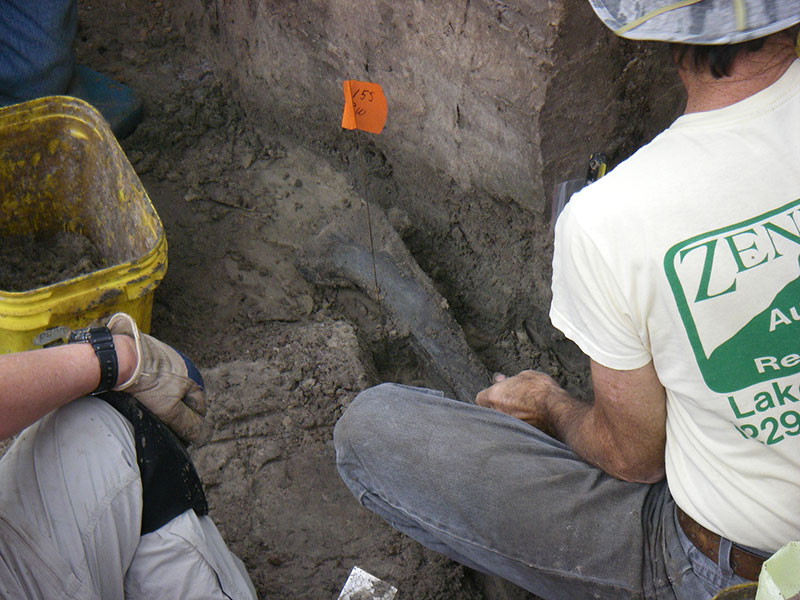
Sources
- Original Author: Richard C. Hulbert Jr.
- Original Completion Date: March 27, 2015
- Editor(s) Name(s): Natali Valdes
- Last Updated: June 16, 2015
This material is based upon work supported by the National Science Foundation under Grant Number CSBR 1203222, Jonathan Bloch, Principal Investigator. Any opinions, findings, and conclusions or recommendations expressed in this material are those of the author(s) and do not necessarily reflect the views of the National Science Foundation.
Copyright © Florida Museum of Natural History, University of Florida